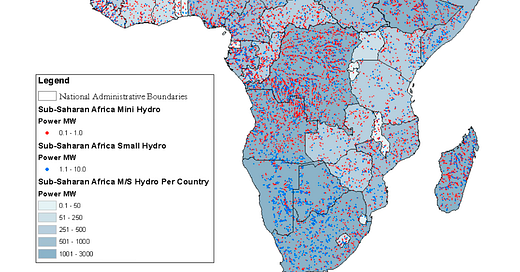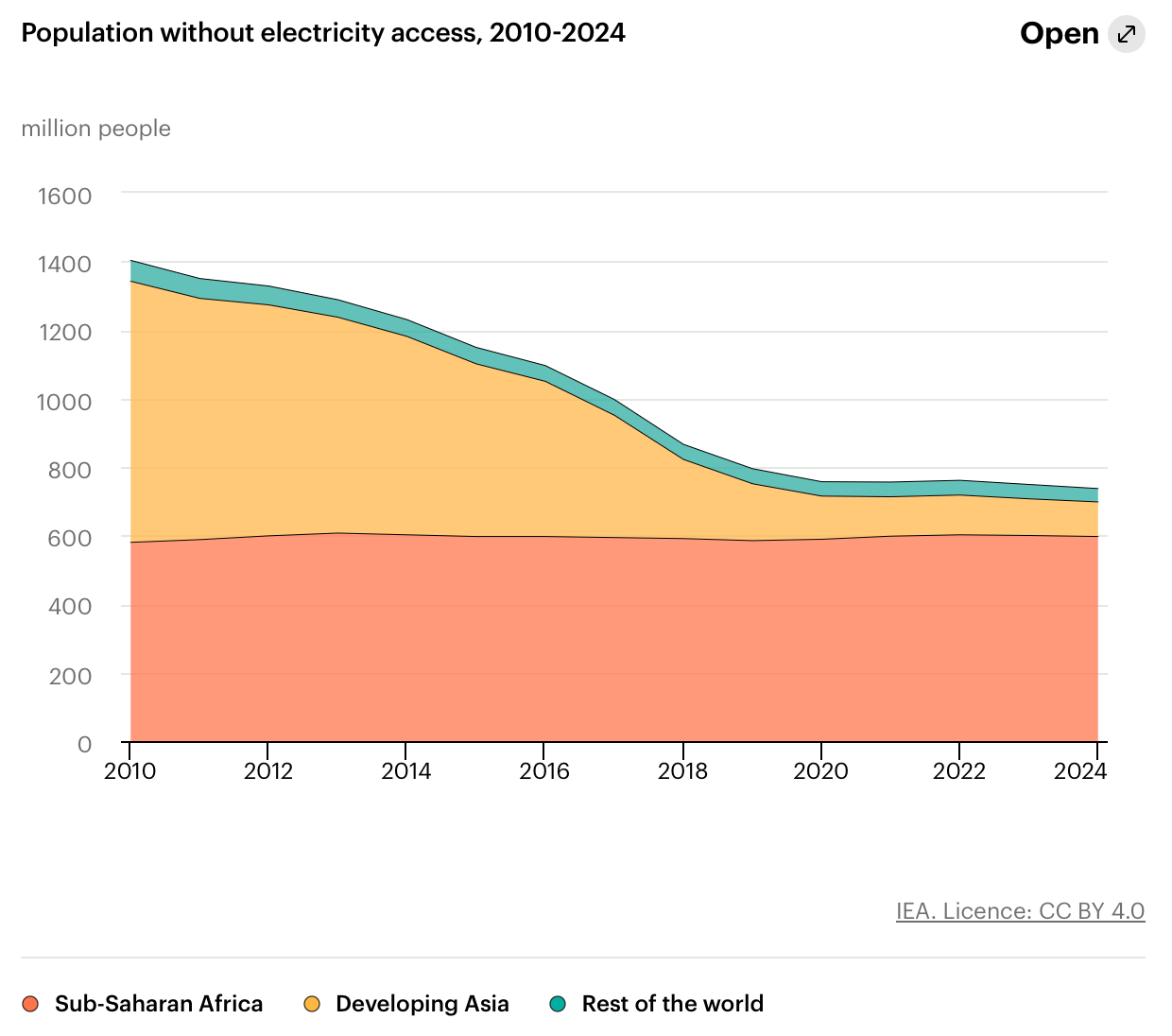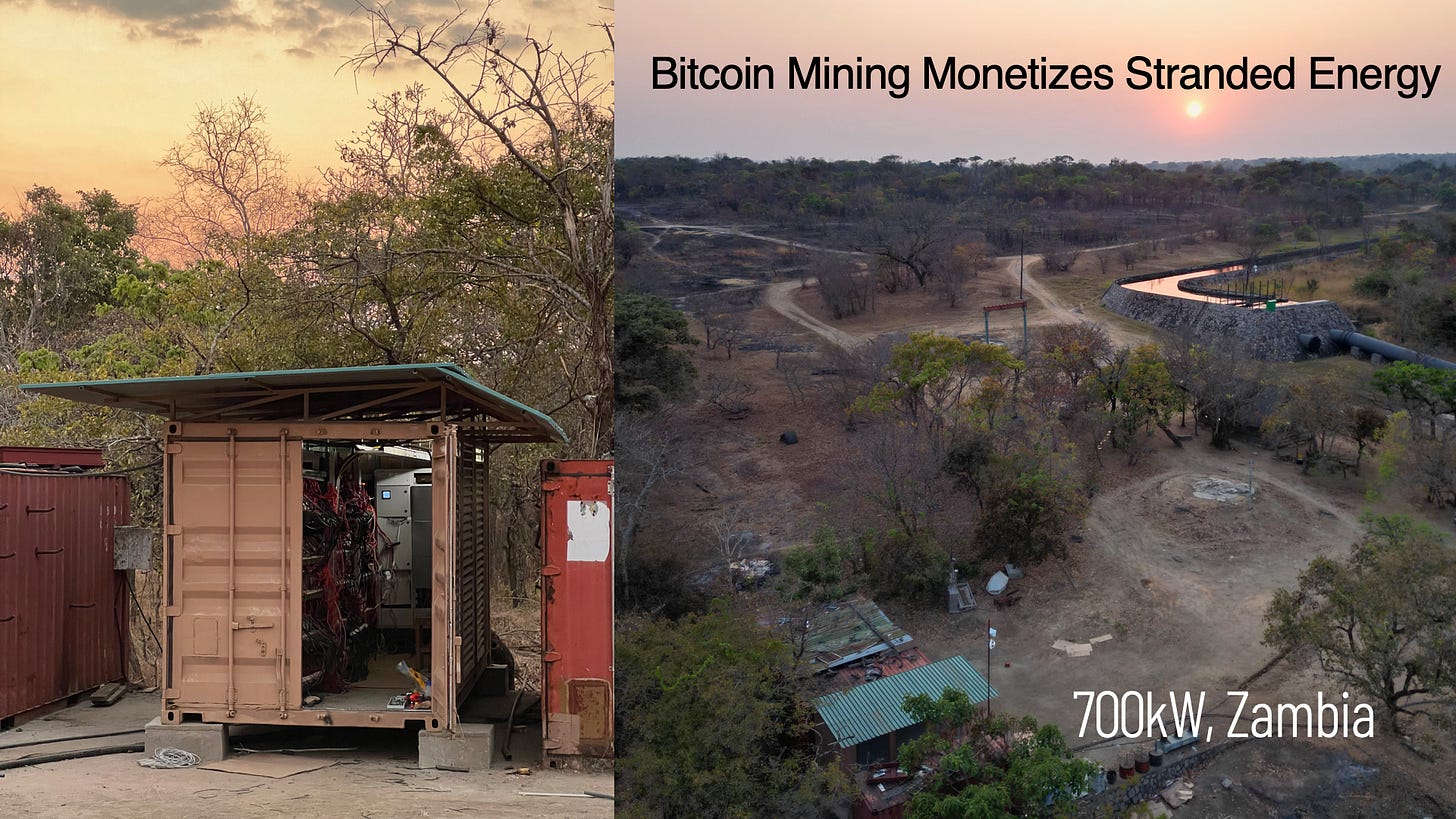Unlocking Energy for 600M: The $20M Off-Grid Solution for Africa
A Scalable, Profitable Approach to Electrifying 600 Million People
Just 10% - 40GW of the 400GW of hydroelectric energy in Africa has been developed (that’s JUST hydro). There is a near unlimited supply of energy to be developed in the one place on earth that needs it most… Africa.
Why?
The story of human advancement is the story of energy—without reliable energy, improved health care, food systems, and cleaner environments are not possible. Energy is the base layer for human progress. It mainly comes into our lives in the form of electricity and we don’t realize just how much more advantaged we are because of it.
Some stats…
Despite being home to 17% of the world’s population, Africa currently accounts for just 4% of global power supply investment.
The USA has over 5.5x the energy consumption as all 1.2b people in Africa combined.
The average consumption per customer is only 6.1 kWh per month across the continent compared to 800 kWh in the US and between 70-300 kWh in South America.
$20M can solve this?
Most of us, myself included, tend to think that $20M is quite a large sum of money. It definitely is for an individual, it usually is for a small business, and even for large companies it is a decent sized investment.
It’s a rounding error for energy development in Africa. Yet it’s the number that is required to break open a new model that will upend a whole industry built on concessionary financing that is paired with small, slow, and bad investments in getting the last large chunk of the world’s population electrified.
An energy industry that has ossified for 50+ years is ripe for new ways of thinking, sometimes done best by outsiders who don’t have any reason to believe the status quo and aren’t worried about the perception of using new technology.
Quickly Understanding Why Africa’s Minigrids are a Bad Investment
Energy investments in Africa require $200B annually through the end of this decade according to the IEA. Much of this will go to large energy generation and national grid development. Mostly these are good and necessary investments, and that is what gives electricity to 800M people, powers large industries, and energizes the small businesses that are the backbone of our economies.
For decades a small cadre of creative and entrepreneurial individuals have been working to power the other 600M people that don’t have electricity, the small businesses in far flung rural communities, and the non-existent industries in those same areas. The spending on offgrid, renewable energy to solve this problem stands at $1-2B annually, which pales in comparison to the money spent on those already electrified which is $8-12B per year.
So, we’re spending 5-10 times more on those who already have electricity compared to those who don’t have any.
Keep in mind the research by IEA over 14 years, ending in 2024, which shows that while other parts of the world have improved in this, that Africa has maintained this 600M who don’t have any electricity.The numbers just don’t make sense. And as I began the foray with my company Gridless in 2022, I just couldn’t make sense of it. Why weren’t there more investments being made in this offgrid energy space?
Unsurprisingly it turns out that 80% of the global non-electrified population lives in remote and rural areas, and extending the national grid to these locations isn’t cost effective. Minigrids become the best option for rural electrification - they are less expensive per megawatt built and they are more resilient than the national power grid.
Minigrids outperform national utilities in the countries where they operate with respect to service metrics, including uptime, power quality, reliable connections and downstream job creation. They have consistently high service uptime, on average above 99 percent, whereas national grids experience significantly more outages.
The World Bank reports that Africa requires 140,000 minigrids to electrify the continent. The Africa Minigrids Association reports that just 5,000 have been built. As an industry, we haven’t even started 5% of needed projects.
Logically, you (and I) would say, “then let’s go build a bunch of these minigrids, solve this problem, and move on.” Even better if they’re renewable energy, let’s do solar, hydro, wind, all of which are abundant in Africa. After all, free fuel inputs make the best energy economics!
Armed with this obvious answer a generation of intrepid entrepreneurs struck out to solve a humanitarian problem and make some money along the way. However, it turns out that dropping a million dollar investment into a poor community that doesn’t have much disposable income doesn’t have the same traction and usage as one might need to get a decent ROI and you definitely are going to struggle being profitable.
Keep in mind that if you’re a smallholder farmer in a rural village in Africa you’ll likely buy an LED light bulb and charge your phone at first. These don’t draw a lot of electricity, but they do change your life considerably. It might be a few years before you invest in that refrigerator, TV, irrigation pump, or electric oven. Demand growth is slower than expected.
In Kenya, we pay $0.22 per kWh in Nairobi for grid power. In the mini grid areas, where people have even less money, they pay $0.36 to over $1 per kWh. For context, the average across the USA is ~$0.12 and in the EU it is ~$0.23. Of course it differs by country, but the overarching result is that these rural populations are charged more than their on-grid counterparts.
Mini-grid business models have traditionally focused on having an anchor client, namely a single large electricity consumer such as a telecom tower, which consumes the majority of electricity supplied by the mini-grid. The anchor client is the first step in the so-called ABC strategy (Anchor—Business—Consumers) for mini-grid financial sustainability. The strategy entails first negotiating an agreement with an anchor client, which has a predictable load profile, and then identifying or helping develop local businesses that can provide stable demand and promote economic growth in the communities. The last step is residential customers, given that this segment cannot guarantee economic viability, but is crucial for achieving the goal of access expansion.
The development and installation of new power assets in Africa is dependent on the successful negotiation and finalization of a credit-worthy Power Purchase Agreement (“PPA”) with a relevant national, regional, or local utility. This process is long, expensive, and generally locks utilities into ‘take or pay’ agreements that require them to purchase 100% of the power produced – regardless of whether or not the energy is needed. Ultimately, this current structure slows down the pace of development, increases costs for developers, and reduces long-term flexibility for utilities (which ultimately increases their costs).
There is no financing without the PPA and there is no project without the financing. This arrangement puts both parties in difficult situations: developers cannot move without the sign-off on a PPA and the utility must make future payment commitments without knowing if there will be a corresponding demand for the energy.
Investors quickly realized this wasn’t a good investment, it made a lot more sense for them to build energy if they could get a 20 year power purchase agreement from the government, which tended to not be in these small unserved communities.
Enter concessionary financiers who take over as the leading driver of this renewable mini grid energy financing - after all this is a human progress issue and it fits their remit.
Investment have been led by the US Power Africa program, the World Bank, UNDP and GEAPP (Rockefeller foundation, IKEA foundation, and the Bezos foundation).
Concessionary financing makes up 72% of financing of minigrids in Africa.
Grants: 52%
Grant and credit: 12%
Concessional loan: 8%
Without a good return on investment, it is clear why concessionary financing is the primary vehicle coming into this space where there is still this willful delusion between financiers and energy developers that there will ever be a return on investment. It can take 5+ years to raise the capital to build a site, which is not a model for quickly electrifying a continent.
“The stringent conditions imposed by these programs can inadvertently create obstacles for developers, complicating the path to electrification in areas that most need it.”
So this means thinking laterally and finding innovative and creative solutions in new technologies that might be out of fashion with the global financiers.
Enter the Gridless Model
Over the last 2.5 years we have proven that minigrids can be made profitable by dropping in a geographically agnostic anchor tenant. We have done this on 6 sites in 3 African countries, using the stranded (wasted) energy from hydro, biomass, geothermal, some of that augmented by solar. The numbers are undeniable, proof positive that this problem has been solved. We don’t need to worry about unrealistic ROI expectations anymore, we now know that you can get a 5-7 year ROI on almost any hydro mini grid that you develop.The simple initial fix is that new offgrid energy can be catalyzed by vertically integrating Bitcoin mining and energy development.
Gridless deploys a containerized – and mobile – data center that acts as the buyer of first resort for 100% of the energy from the independent power producer (IPP). This allows the project to be financed, developed, constructed, and commissioned without reliance on or support from the utility – enabling much more rapid deployment at a lower overall cost.
Once the project is operational, the IPP can then work with local utilities, either mini grids or national utilities, to provide power only when needed. For the utility, this additional power base can be fully aligned with existing demand to ensure that the only power that is bought is the power that can be sold to customers.
Bitcoin isn’t just a savings and money tool - it’s also a catalyst for energy. From boosting profitability to stabilizing grids and driving new energy development, Bitcoin powers more than just finance.But how does $20M break this cycle of stagnation and ineffectiveness in Africa’s rural electrification challenge?
Surprising to us at Gridless was that you can build an endless energy growth cycle by using Bitcoin as the financing vehicle as well.
(Note: We are openly developing this model so that anyone can do what we’re doing, as one company alone cannot develop all of the energy required.)
Gridless is pioneering a revolutionary model for energy development in Africa by creating small, cash-flow-positive energy sites across multiple countries. With 600 million people still lacking access to electricity, Africa’s off-grid energy sector is broken, but Gridless has a solution: integrating bitcoin mining data centers into rural renewable energy sites from day one of production to fully monetize stranded power and drive sustainable growth.
Often small communities are not targeted for energy development. Once a feasibility study is done, even if the renewable energy location and costs are manageable, the community is put on the back burner until it has grown. In the case of bitcoin financing and monetization, this is no longer necessary and these communities can be electrified even as they grow.
Our goal is to connect 50 million people to sustainable, off-grid electricity by 2040 through the development of 1GW of run-of-river hydro power. By using Bitcoin as a financing tool, Gridless Energy leverages a “financial reactor” effect, where an initial investment in bitcoin can develop new energy, which in turn generates more bitcoin to fund further energy expansion. This creates an exponential growth cycle, enabling us to build 10x more energy in 10 years and up to 148x more in 30 years—all from the same initial investment, without ever selling a single Bitcoin.
This model is so capital efficient that it reduces the cost of energy development to just 5% of what traditional models would require—cutting costs from $2.2 billion to just $110 million. This makes renewable energy access both scalable and financially sustainable for millions across Africa. Gridless offers an unprecedented opportunity to finance energy infrastructure, bring electricity to underserved communities in the region that needs it most in the world, and to further decentralize the Bitcoin network.
We are raising the initial $20M towards this purpose. We are holding all of this capital on our balance sheet as bitcoin, and then leveraging the bitcoin through USD loans. Gridless is able to create an extremely efficient financial engine that can continually fund new development of energy over time - even withstanding large fluctuations in the BTC price.
Said a different way:
$20M today will build you 10MW of small hydro. In 30 years, unless you raise more capital to build more, you will only have 10MW.
$20M converted to bitcoin builds 100MW in 10 years and 1-4GW over that same 30 years.
The capital efficiency is unmatched.
With all of the energy money sloshing around Africa, it is simply indefensible not to put $20M towards this new model.
Solving for Affordability
Most of what we have been discussing is the availability of electricity to those that need it most and we have not been addressing the problem of affordability, which is another issue that comes with minigrids in Africa. Much of the time the costs of energy will range from $0.30 to over $1.00 per kWh due to the stranded energy problem brought about by slow adoption by a poor community for the energy developer and the effect that it has on their operational ability. This is a lot more expensive than national grid electricity prices, so the people who are the poorest are asked to pay the most. It turns out that the use of bitcoin mining as the buyer of first resort, the anchor tenant on a site, solves this problem.
Due to the nature of the bitcoin network, all bitcoin mining ties into a global energy marketplace and is paid out at a global rate, which statistically has been between $0.06 to $0.11 per kWh. In effect, this creates a price floor for any energy that has bitcoin mining as a part of its use. If anyone pays just 1 cent more, then the electricity should be sold to them and the bitcoin mining rigs shut down. So if the bitcoin energy market is paying 10 cents per kWh and you offer it wholesale at 11 cents, then you should be able to offer it up to the community at a much lower price than even the national rates.
Bitcoin’s networked energy market becomes the market maker and creates a global rate that impacts offgrid power sites.
Put a Positive Dent in the World
All meaningful change that we have seen in this world has taken outliers working on ideas at the edge. If we want change, we need to take risks. The Gridless model is just that, an intelligent risk brought to the world by seasoned Africa operators looking at an old problem in a different way.
The economics and impact of run of river hydro is unequaled; for bitcoin, for energy, and for Africa.
For energy, we can finally make offgrid energy profitable. By creating a constellation of renewable minigrids across the continent, it provides more electricity with a lot more reliability than centralized grids, and it’s done cheaper and therefore can be less expensive for the communities to buy.
For Africa, we can finally put a dent in the 600M Africans who still live without electricity.
For bitcoin it takes the decentralization of the mining network even further, pushing 100+ sites across 15 countries that would normally never have any bitcoin mining. And it does it at a small scale instead of these large vertically integrated 200+MW mining farms.
Let’s do something meaningful with our time, our money, and our energy.
Data from the following sources:
https://www.seforall.org/system/files/2024-08/SOTM%20Report%202024_EN_vFc.pdf
https://www.esmap.org/mini_grids_for_half_a_billion_people_the_report
https://africamda.org/2022/07/01/benchmarking-africas-minigrids-report-2022-key-findings
https://www.gogla.org/reports/january-june-2024-sales-and-impact-data/
https://africamda.org/2022/07/01/benchmarking-africas-minigrids-report-2022-key-findings/
https://www.esmap.org/Mini-Grid-Solutions-for-Underserved-Customers
https://www.pv-magazine.com/2023/03/29/minigrids-edging-closer-to-profitability/
https://iea.blob.core.windows.net/assets/aeadbc3e-5020-4c83-bcfe-6a00d1aca49c/CleanenergyinvestmentfordevelopmentinAfrica.pdf











